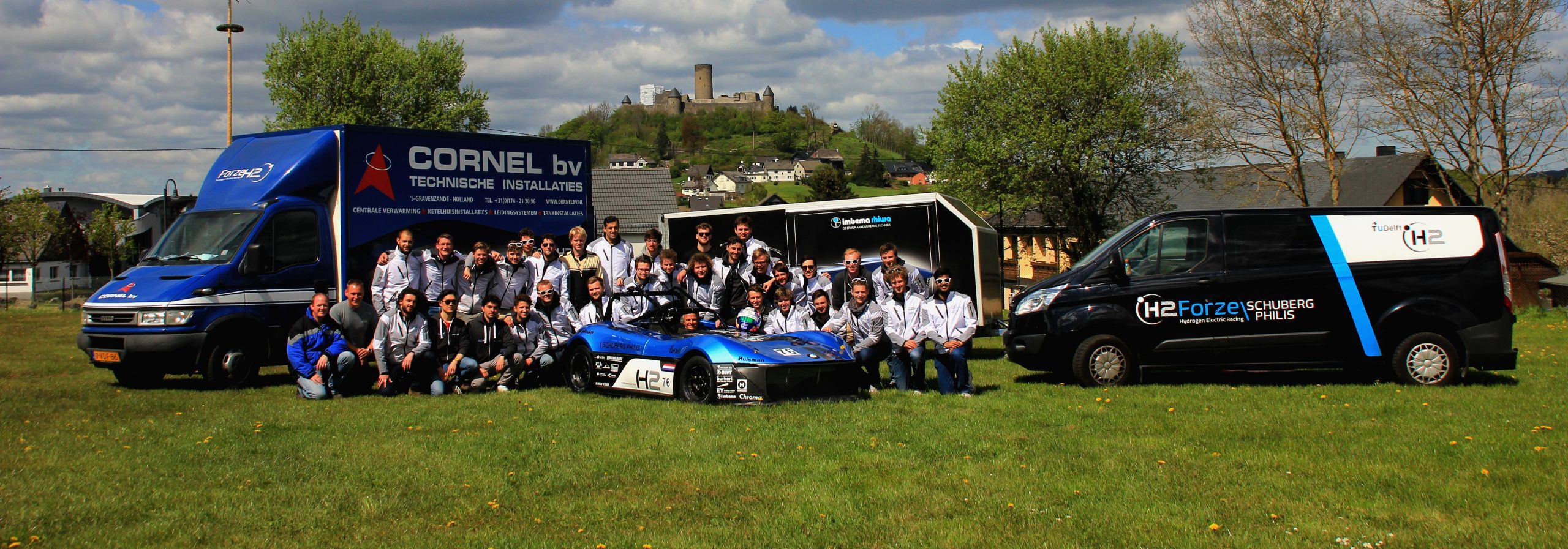The Forze student racing team delivered on their ambition to break the record for hydrogen fuel cell cars at the Nürburgring last weekend. Dutch Formula-One driver Jan Lammers completed the track in the Forze VI under 11 minutes.
Completing the Nürburgring is a milestone for any racing team, and Forze VI is the first student-built hydrogen cell racing car to do so, making it a significant event both for the group and for TU Delft. Team leader Menno Dalmijn told Delta that although the car’s top speed is theoretically 220km per hour, they only reached 170km per hour on the Nürburgring track and they have not yet found out how well the car will do doing 220km per hour, although they plan to test this. The record-breaking lap was more than a morale booster. It has allowed them to gather data on Forze VI’s performance. The data collection is an important part of test-laps offering the opportunity to optimise the cars’ performance and pin-point any technical or other difficulties, although according to the team when it comes to Forze VI performance, there is little to work on as it drives exactly like an electric car. The significance of completing the lap at the Nürburgring as opposed another track or testing facility, according to Dalmijn, was to show-off what the team can do, as to complete the ring “the car has to be extremely well designed, and that’s why we went there.”
Forze has been working on hydrogen technology since 2008, with their research for the last two and a half years focusing particularly on the development of a racing car. Originally the group built hydrogen fuelled go-karts before moving onto the racing cars themselves. The current Forze VI is the sixth incarnation of their car and, although very similar to the model the team drove last summer, is even further developed with the fuel cell fully functioning. The model used last-year, according to Menno Dalmijn, ran on an electrical system, rather than the new hydrogen system.
The fuel cell used in Forze VI is capable of doing 100 kilowatts, however the test in May only used 50kw as the cell is still in the testing phase. The energy buffer system which the team developed allows energy from the cell to be stored when it is not being used, for example in corners. This buffer means the system can generate 190kw – the cell’s peak power output.
The car, which takes hydrogen tanks with 360bar pressure, is currently designed to drive at full throttle for 30 minutes before refuelling at mobile refuelling stations, and with hydrogen tanks refuelling within minutes, like petrol cars, there is great potential for practical, long-distance travel using this technology.


Over 70 students, around 50 of them from TU Delft, worked on Forze VI. The team is comprised of students from various faculties who want hands-on experience in the field of engineering, and most aspects of the team from management to PR is done by students. Students from De Haasge Hogeschool, Rotterdam Business School, Rotterdam University and Leiden University contribute to the project, however the majority are from TU Delft where the team is based.
After completing their goal of breaking the record, what is in store for the Forze VI and for the team? There is increasing interest in setting up hydrogen racing competitions, with hydrogen cars far more efficient than their battery operated electric counter-parts. Dalmijn stated that though the racing season is up-coming the Forze VI is a car “meant for breaking records, not racing”, but what they hope to do next is develop a car that proves hydrogen cell technology has the ability to race, potentially even against petrol cars; “it has huge potential”.



Comments are closed.